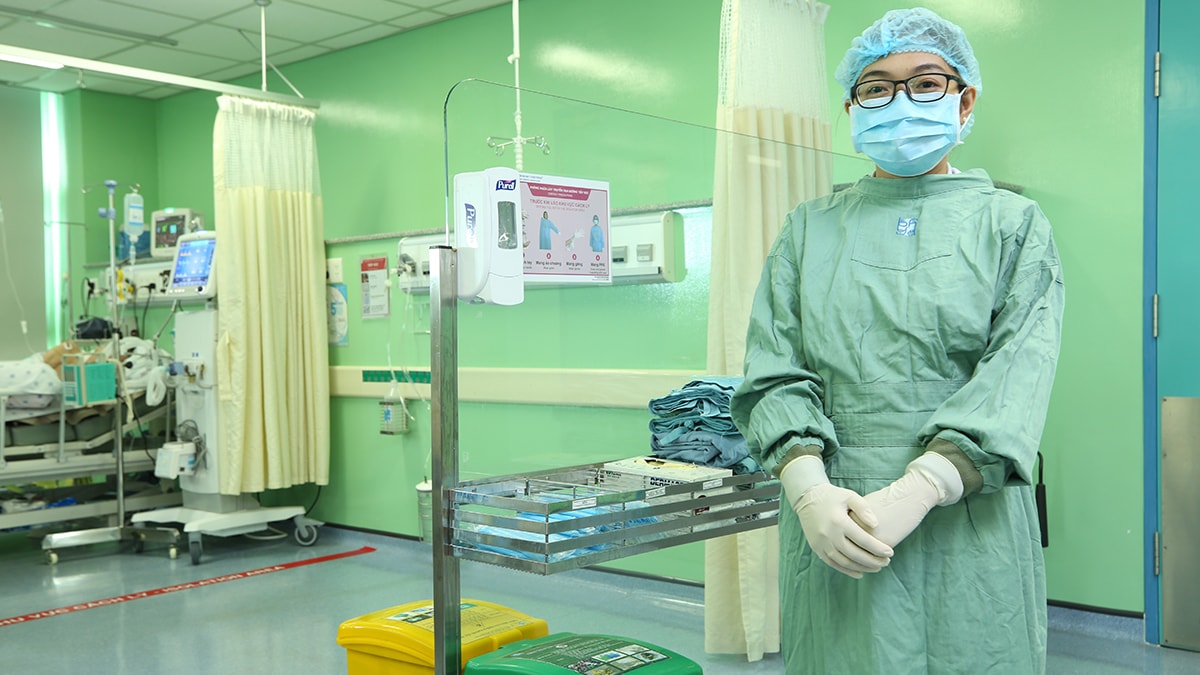Key points
- With CDC support, a hospital in Vietnam has established infection prevention and control measures to help stop the spread of carbapenem-resistant Enterobacterales (CRE), identified as an urgent antimicrobial resistance (AR) threat in CDC's 2019 AR Threats Report.
- Lessons learned from Vietnam inform the work of CDC's Global Action in Healthcare Network (GAIHN), which addresses healthcare-associated infections and antimicrobial resistance in healthcare settings around the world.

Combatting an urgent antimicrobial resistance threat
Vietnam has adapted established infection prevention and control (IPC) measures for limited-resource settings to help stop the spread of carbapenem-resistant Enterobacterales (CRE), identified as an urgent antimicrobial resistance (AR) threat in CDC’s 2019 AR Threats Report.
A CDC-supported initiative at The University Medical Center Ho Chi Minh City (UMC) in Vietnam that used IPC quality improvement (QI) strategies to reduce CRE colonization and infection in a general intensive care unit (ICU) demonstrates the positive impact that IPC activities can have on CRE prevention.
Challenge
CRE are a type of resistant bacteria that are concerning because they can spread quickly in healthcare settings and cause severe, difficult-to-treat infections. However, some people can also be colonized with CRE, meaning the bacteria are alive and growing on or in a person’s body without the person having symptoms. When someone is colonized, they are not actively sick, but colonized individuals may be more likely to develop CRE infections in the future, and they can unknowingly spread CRE to others. IPC is critical to prevent the spread of these bacteria in healthcare settings.
UMC was known to have high prevalence of CRE. Seventy-seven percent of general ICU patients tested there in June 2019 were found to be colonized or infected with CRE, and many of these patients likely acquired the bacteria while in the hospital.
Solutions
With CDC’s support, the QI CRE prevention activities began in September 2019, with the goal to decrease the number of patients newly diagnosed with CRE infection or colonization in the ICU by 50% over one year. Key activities included:
- Screening all ICU patients for CRE on admission and every 2 days
- Isolating any patient found to be infected or colonized with CRE
- Establishing cohort areas in the healthcare facility to care for CRE patients
- Enhancing hand hygiene monitoring for healthcare providers
- Enhancing environmental cleaning and monitoring practices
- Training IPC and ICU staff on these activities
Results
Implementing effective IPC in resource-limited settings can be challenging for many reasons, including poor hospital infrastructure, inadequate human and material resources, and hospital overcrowding.
Rates of CRE infection and colonization greatly decreased
Over the course of the year-long QI project, cases of CRE infections and colonization decreased by 85%, from 15.0 cases/100 patient-days in September 2019 to 2.3 cases/100 patient-days in August 2020. These impressive results have been sustained in the years since the project ended. UMC has continued IPC interventions including screening all ICU patients for CRE (decreased to weekly frequency) and maintained incidence of new CRE cases between 2.0 and 4.0 cases/100 patient days.
When prevalence of AR is high in a healthcare setting, healthcare workers may feel powerless to fight this public health threat. However, UMC's success shows that even in the face of high prevalence and limited resources, commitment to implementing IPC best practices can help healthcare workers effectively protect patients in the battle against AR and help save lives.
Expanding success
Motivated by their success, UMC, with continued CDC support, hopes to expand these activities to additional ICUs in the hospital and to mentor other hospitals in Vietnam to have similar success.
Informing global action
In 2019, AR infections are estimated to have killed at least 1.27 million people worldwide and were associated with nearly 5 million deaths, more than either HIV or malaria.1 That same year, the World Health Organization declared AR to be one of the top 10 public health threats facing humanity. Recent studies indicate that the United States and other countries lost progress combating AR during the COVID-19 pandemic23, meaning that the problem continues to grow and evolve in all regions of the world.
The Antimicrobial Resistance Module of GAIHN (GAIHN-AR), a part of CDC’s Global Antimicrobial Laboratory and Response Network, uses an approach similar to UMC’s to protect patients and healthcare workers from critical and emerging AR threats. GAIHN-AR healthcare facilities collaborate with laboratory and IPC experts from the local to the global level to detect AR organisms in healthcare settings, communicate about detected threats, and respond by implementing IPC actions.
Learn more about CDC’s work to detect, prevent, and respond to AR globally.
- Antimicrobial Resistance Collaborators. (2022). Global burden of bacterial antimicrobial resistance in 2019: a systematic analysis. The Lancet, 399(10325). https://doi.org/10.1016/S0140-6736(21)02724-0
- CDC Special Report. 2022. COVID-19 U.S. Impact on Antimicrobial Resistance. https://www.cdc.gov/antimicrobial-resistance/data-research/threats/covid-19.html
- Patel, T., Sati, H., Lessa, F.C., et al. (2024). Defining access without excess: expanding appropriate use of antibiotics targeting multidrug-resistant organisms. The Lancet Microbe, 5(1). https://doi.org/10.1016/S2666-5247(23)00256-2
